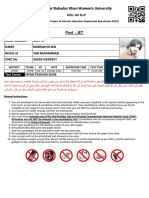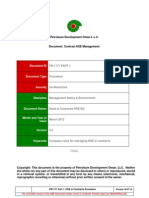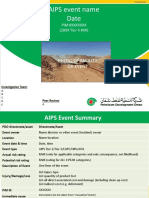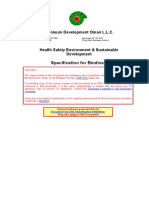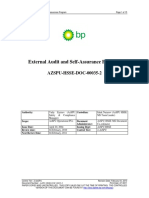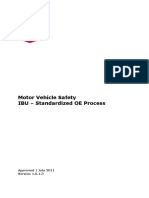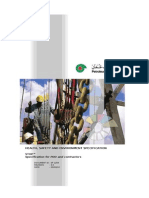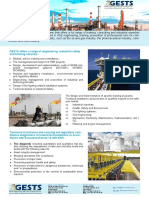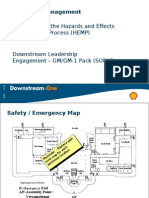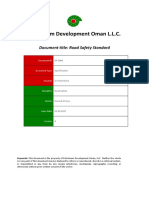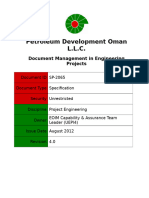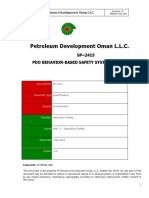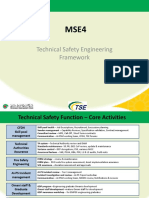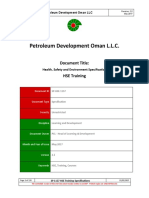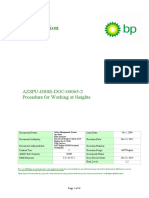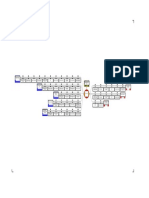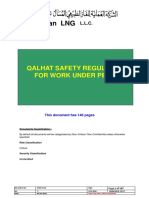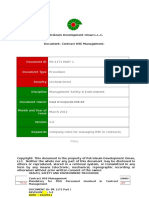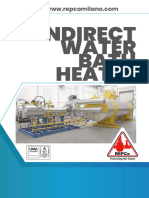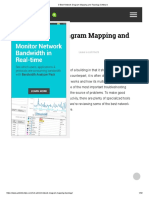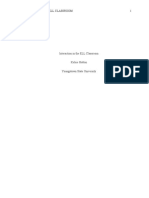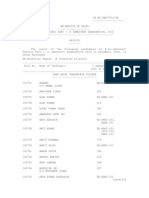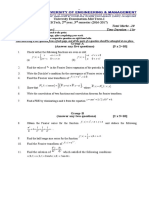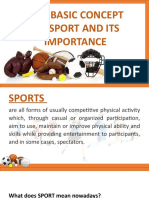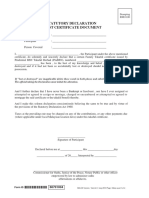Glossary: Pdo Hse Management System Manual (CP-122)
Glossary: Pdo Hse Management System Manual (CP-122)
Uploaded by
kaizen989489Copyright:
Available Formats
Glossary: Pdo Hse Management System Manual (CP-122)
Glossary: Pdo Hse Management System Manual (CP-122)
Uploaded by
kaizen989489Original Description:
Original Title
Copyright
Available Formats
Share this document
Did you find this document useful?
Is this content inappropriate?
Copyright:
Available Formats
Glossary: Pdo Hse Management System Manual (CP-122)
Glossary: Pdo Hse Management System Manual (CP-122)
Uploaded by
kaizen989489Copyright:
Available Formats
PDO HSE MANAGEMENT SYSTEM MANUAL (CP-122)
Glossary
CHAPTER 9
GLOSSARY Understanding the meaning of common terms in the PDO HSE-MS / CP-122 is an essential part of professional HSE management. It is important that PDO establish its own documented definitions and terms for relevant HSE management system terminology, so as to reduce the potential for reporting and other communication problems. This glossary is not exhaustive, and the definitions and abbreviations provided here are for reference only.
Accident - The term accident is sometimes used to describ e an incident which has caused actual injury, loss, or damage. For the purposes of PDO procedures the term accident shall not be used. (See incident. The following definitions beginning with the term accident are for illustrative purposes only and the term incident can be substituted for accident here.). Accident / incident rates - Measures of accident / incident loss experience within given time periods, developed as a means of comparison. (Examples: injury frequency rate, injury severity rate, injury index, all injury frequency rate, major property damage rate, and critical items damage rate). Accident report - A written summary describing the accident / incident, presenting an analysis of causes and suggestions for remedial action, and documenting actions taken as preventive or control measures. Accident / incident analysis - Study of accident / incident experience through compilation of related facts and information about the nature of injuries and/or damage, and the causal factors. The purpose is to define trends and problem areas and to identify the critical safety problems as a basis for program objectives and activities. Analyses usually include frequency of occurrence, severity, nature of injury / damage, part of body injured, part of equipment or material damaged, agency of the accident, substandard practices and conditions, job factors and personal factors. Refer to Basic Causes and Immediate Causes. Accident / incident investigation - A systematic search for factual information on the extent and nature of a specific loss or near-miss, the related events, the substandard practices and conditions which influenced the events, the basic or roots causes, and the management actions needed to prevent or control future occurrences. AI-PS - Asset Integrity Process Safety. AIPSALT - Asset Integrity Process Safety Asset Leadership Team. ALARP - As Low As Reasonably Practicable (ALARP). Risks are said to be reduced to a level of ALARP, at a point where the time, trouble, complexity, difficulty, and cost of risk reduction measures have been assessed, and where further risk reduction measures are considered to be unreasonable in regard to the additional risk reductions obtained versus the costs and benefits of doing so. All - This term generally refers to a 100% condition. The established method to evaluate an "all" condition is to apply the "3 strikes rule." The "3 strikes rule" means that the third time a deviation is noted, the "all" condition will not be true. (From the HSE-MS Framework Scorecard [FSC]). Aspect - The potential to harm people and the environment, cause damage and/or loss of assets, and adversely impact PDOs reputation. (See Hazard). When used in conjunction with environment, as environmental aspect, it has a slightly different meaning (see Environmental aspect). Assessment - (1) A comprehensive, systematic assessment of performance to established and accepted criteria.
Page 1
PDO HSE MANAGEMENT SYSTEM MANUAL (CP-122)
Glossary
CHAPTER 9
(2) (HSEQ) A systematic and independent examination to determine whether HSEQ activities and related results comply with planned arrangements and whether these arrangements are adequately and effectively implemented, and are suitable to achieve objectives. (See Audit). Asset Integrity - See Technical Integrity. Assumption - The rationale on which normative behaviors and beliefs are based. Assurance - A positive declaration intended to give confidence. Full confidence, freedom from doubt, certainty. Audit - (1) A comprehensive, systematic assessment of performance to established and accepted criteria. (2) (HSEQ) A systematic and independent examination to determine whether HSEQ activities and related results comply with planned arrangements and whether these arrangements are adequately and effectively implemented, and are suitable to achieve objectives. (See Assessment). Authority - The capacity to give commands which are accepted as legitimate by others. In the modern organization the manager's authority to give instructions to subordinates is drawn primarily from his formal position as a manager, and from the set of rights and obligations formally associated with the post, rather than from the manager's individual leadership qualities. However, both sources of authority can be important. Banding - A process which details the contractor selection process for High and Medium Risk services to Petroleum Development Oman (PDO). The SP-1171 document describes the methodology that presents a consistent and standardized approach to HSE evaluation of contractors. The approach also aims to reduce the repeated data requests, for HSE information, from contractors as part of the technical evaluation process. The overriding objective is to reduce contractor incidents in PDO and to prioritize doing business with contractors who have a good HSE capability and performance. Basic causes - The job and personal factors, such as inadequate engineering, lack of knowledge or skill, etc., from which the substandard acts and/or substandard conditions originate. Basic causes may also be referred to as underlying, root or real causes, systems defects or contributing causes. Basic causes are most frequently the result of an inadequate management system, inadequate management system standards, and/or inadequate compliance with management system standards. (See Immediate Causes). BBS - Behavioural Based Safety. A system or program to identify, evaluate, control, and monitor behaviors in an organization in order to change and improve safe behaviors and/or to reduce at-risk behaviors. Behavioral observation - The process of observing how individuals conduct themselves with reference to rules and practices, in order to reinforce and improve desired standards of behavior. Benchmarking - Predetermined standard(s) against which research or assessments are measured. Budget - A firm's predetermined financial plan, expressed in quantitative or financial terms, for a given future period. (Examples: the sales budget is generally compiled with the aid of sales forecasts and shows quantities and values of planned sales broken down by product group, area and type of customer. The distribution costs budget shows planned distribution activity measured in packages, tonnage, etc., and associated warehousing and transport costs. The master budget aggregates all other budgets to produce a budgeted profit -and-loss account and balance sheet.). Business Assurance Letter The Business Assurance Letter is a corporate PDO exercise conducted by Finance and with submissions made to stakeholders. This exercise involves all the functional departments, including MSE. The intent is to assure, with or without qualifications, that the current implementation status and integrity of the HSE-MS meets suitability, adequacy, and effectiveness requirements. PDO Leadership should consider whether the Business Assurance Letter can be made without qualification. In making their appraisal of whether or not a Business Assurance Letter can be made without qualification, Leaders may consider how an auditor would rate compliance with the Letter concerned. Letters should be qualified if a significant audit finding would be expected. An audit trail should exist to confirm the basis on which all Letters have been made. Business continuity planning - Arrangements for restoring business activities as soon as possible following an emergency to minimize loss to business and impact on stakeholders.
Page 2
PDO HSE MANAGEMENT SYSTEM MANUAL (CP-122)
Glossary
CHAPTER 9
Business controls - Structured means used to provide reasonable assurance that business objectives are properly set and are likely to be met with little risk of unacceptable deviation. Can - indicates a possible course of action. (See May). CCPS - The Center for Chemical Process Safety, an American organization which has established guidance standards for developing and implementing process safety management systems. The CCPS process safety management system standards consist of 20 elements. For further information see their website at www.aiche.org/ccps CEPI - Composite Environmental Performance Indicator. Chemical - A chemical may be a liquid, gas, solid, or powder which in normal use has the potential to cause a heath and/or physical hazard, and/or the release of toxins into the environment. This definition also includes any materials that will be created during the manufacturing process, either as intermediates, by-products, and/or wastes. A chemical may be further defined as: Used or consumed in the manufacturing, R&D, testing or assembly of products; Incorporated into the final product; Used or consumed in the maintenance of facilities, grounds and equipment; Raw materials, that when handled / processed at a site, can cause releases of potentially hazardous emissions, by-products or wastes; Any material received on site with a Material Safety Data Sheet (MSDS); Any material requiring an MSDS, either regulatory, or as required by PDO Policy (stated in Chemical Management Standards); Certain metal articles that are consumed (i.e., tooling, weld rods, braze tapes, electrodes, etc.). A chemical may be a direct or indirect material. (From the HSE-MS Framework Scorecard [FSC]). CM - Corrective Maintenance. Coaching - The day-by-day actions you take to help people perform as well as possible. Code of Practice (CP PDO) - A high level document that specifies the overall approach and procedure for performing a business process / activity, and which states the minimum requirements expected from employees, contractors, and/or other relevant stakeholders. Codes - Rules and standards which have been adopted, by a governmental agency or professional regulatory body, as mandatory regulations having the force and effect of law. Commitment, management - Visible participation of the (senior) management of their organization's improvement efforts. Their participation may include establishing and serving on an HSE committee, establishing HSE policies and goals, deploying goals to lower levels of the organization, providing the resources and training that the lower levels need to achieve the goals, participating in quality improvement teams, and reviewing progress organization-wide. Communication - What we do to give and get understanding. Company - This term refers to PDO, a PDO asset, a PDO business facility / operation, or a PDO affiliate. It excludes contractors or other non-PDO entities. (From the HSE-MS Framework Scorecard [FSC]). Competence - The ability, in terms of skill, knowledge, and awareness to perform a role within specified standards. Competence is developed over time from among a combination of education, training, and/or experience. Competitive strategy - Deciding, on the basis of an evaluation of the firm's own competitive strengths and weaknesses vis--vis those of its rivals and the requirements of the customers, the direction(s) that firm will pursue. Complete task observation - An observation, planned in advance, of the complete task, using the established task procedure and/or the most recent task analysis worksheet as references, and recording the results on a specific form. Contingency measures - Measures that could be taken if an event occurs, in order to minimize its consequence. Consequence - The effect, result, impact, or outcome of something occurring earlier. Continual improvement - The ongoing improvement of activities, products, services, and/or processes through small steps and breakthrough improvements.
Page 3
PDO HSE MANAGEMENT SYSTEM MANUAL (CP-122)
Glossary
CHAPTER 9
Contract - Legally binding document or situation in which a seller undertakes to supply goods or services to a buyer in consideration of some financial or other return. Contractor - Person or company that conducts work under a contract for the organization. (See also Sub-contractor). Contractor banding - See Banding. Control - (1) The process of ensuring that activities are carried out as intended. Control involves monitoring aspects of performance, making commendations and taking corrective actions where necessary. (2) Physical device to regulate a machine, apparatus, or system within prescribed limits or physical standards of safety and operating effectiveness. Controls - Controls include preventive measures (reducing the likelihood / probability), mitigative measures (reducing the number and severity of consequence) and recovery or recovery preparedness measures (reducing the chain of consequences arising from a top event). Controls are also called risk reduction measures, preventive measures, barriers, and/or mitigative measures. Coordination - The process of combining the work of organization members and departments to achieve the desired end-product or goals of the organization. Corporate Governance - Defining and implementing a system of rules, processes, procedures, and relationships to manage the organization and fulfill its legal, financial, and/or ethical obligations. Corrective action - Any activity undertaken to address an incident or non-compliance, and if possible, to prevent its recurrence. Crisis - An emergency where the situation has escalated to the point where there is actual or potential media interest which might have a negative impact on reputation at the corporate level and could threaten the survival of the business. Critical controls - A control or contingency measure which is absent or ineffective would result in at least one risk becoming unacceptable. Critical / vital few - A basic management principle which states that a small percentage of specific items, actions, or activities account for the majority of all accidents and costs. Often referred to as the Pareto Principle. Critical equipment - Machinery, equipment, and/or materials that is likely to result in a major loss to people, property, process and/or environment when worn, damaged, abused, misused, improperly applied, etc. These critical few pieces of machinery, equipment, and/or materials which, when worn, damaged, abused, misused, or improperly applied, are more likely to result in a major loss. Critical equipment list - A comprehensive list that includes all critical equipment, machinery, and/or materials at the location that have historically resulted in the majority of losses (including injury or illness) or have the potential to do so. The list should include a statement of the criteria used to identify their criticality. Critical supplies inventory - Activity to identify, register, and evaluate critical spare parts or components resulting in a comprehensive list of the ones which have historically resulted in major quality problems or nonconformities or which have the potential to do so. Critical task - A specific element of work which historically has produced and/or which, when not properly performed, may produce major loss, either during or as a result of the task. CSU - Commissioning and Start Up. Culture - (1) The customary beliefs, social forms, and material traits of a racial, religious, or social group. (2) The characteristic features of everyday existence shared by people in a place or time. (3) The way the organization believes, thinks, and acts with respect to risk. Customer complaint system - A structured method to handle and solve individual customer complaints and to take corrective actions to avoid or minimize all customer complaints. The system should cover: registration, analysis, solving complaints, customer feedback, preventive action, information to employees and customer(s), and evaluation of actions. Customer feedback - Information received via meetings, personnel talks, complaint forms, etc., from existing or new customers.
Page 4
PDO HSE MANAGEMENT SYSTEM MANUAL (CP-122)
Glossary
CHAPTER 9
Customer satisfaction - The most important criteria in all quality work in the organization. Approximating or exceeding customer expectations. DCAF Discipline Controls and Assurance Framework. Design - The process of translating a product idea into a product which can be produced and marketed on a commercial basis. Design failure - A failure due to inadequate design of an item. Design input - All documents required to serve as source for basic information for development and design. (Examples: customer requirements, rules and regulations from external authorities, functional requirement lists, contract documents, engineering handbooks and technical standards, and design data from suppliers). Design output - The final work result of the development and design function. (Examples: drawings, technical specifications, manuals and bills of materials). Design review - A formal and independent examination of an existing proposed design for the purpose of detection and remedy of deficiencies in the requirements and/or design which could affect such things as reliability performance, maintainability performance, maintenance support performance requirements, fitness for the purpose and the identification of potential improvements. (Note: Design review by itself is not sufficient to ensure proper design.). Design verification - Activity to check whether the design (work results) meets the input requirements by conducting design reviews, qualification tests, alternative calculations, and comparison with similar proven designs. DI - Design Integrity. Directive, management - Specific instruction from management. Disability - Any injury or illness, temporary or permanent, which prevents a person from carrying on his or her usual activity. Disabling injury - A work injury which results in death, permanent total disability, permanent partial disability, temporary total disability, or restricted ability to perform normal work. Distribution - The process of storing and moving products to customers, often through intermediates such as wholesalers and retailers. The task of physical distribution management involves moving specified quantities of products to places where customers can conveniently buy them, in time to replenish stocks, in good condition. The objective is to maximize availability of product while minimizing cost of distribution (synonym: physical distribution). Document - A paper and/or electronic file containing information. Document control - The operational techniques and activities to ensure the right and proper use of all documentation in the organization. Document control addresses: document layout, approval, issue, changes, modifications, distribution, and removal of obsolete documents. Document distribution list - Comprehensive list mentioning document numbers, date of issue, revision number, document name, quantity issued, department of issue, department of destination, file storage place, retention, etc. Documented - Written information about an activity. Dosimeter - A personal device used to monitor an individual's exposure to an occupational health hazard, such as radiation, vibration, noise, etc. Duty of Care - An obligation and concept that a sensible person / organization would apply or use in circumstances when acting towards the public, and/or other stakeholders. Considered in some countries to be a legal requirement. If the actions of a person or organization are not made with watchfulness, attention, caution, and prudence, their actions are considered negligent. Consequently, the resulting damages may be claimed as negligence in a lawsuit. PDO has now formerly adopted the term to mean it will take full cognizance of the
Page 5
PDO HSE MANAGEMENT SYSTEM MANUAL (CP-122)
Glossary
CHAPTER 9
health and welfare of all employees, contractors, and other persons that may be affected by its operations in Oman. The duty of care shall in particular monitor the working and living conditions of the workforce. Economic quality - The economic level of quality at which the cost of securing higher quality would exceed the benefits of the improved quality. Effect - An adverse impact on people, the environment or PDOs reputation; damage and/or loss of assets. (See Impact). Emergency - A situation that poses an immediate threat to human life, major / serious damage to property / assets, the environment, product / service and other quality matters, and/or the security of the site / organization. Emergency needs assessment - The process of recognizing and evaluating potential emergencies that could occur in an organization. Used as the basis for developing a comprehensive emergency response plan. Emergency plan - A comprehensive document to provide guidance on actions to be taken under various possible emergency conditions. Includes responsibilities of individuals / departments, resources available for use, sources of aid outside the organization, procedures to follow, authority to make decisions, requirements for implementing procedures within departments, training in and practice of emergency procedures, communications, and reports required. Emergency team - A group of employees who act as a unit in some or all types of emergencies. Employee - A person employed by PDO who is not directing or controlling the activities of a group of workers. (From the HSE-MS Framework Scorecard [FSC]). EMS coordinator / Management Representative - A person, reporting to upper management, one of whose functions is to measure and evaluate the environmental management system effectiveness. The coordinator also advises and assists on matters relating to the environmental management system. Environment - Surroundings in which an organization operates, including air, water, land, natural resources, flora, fauna, humans, and their interrelation. Environmental accident - An unintended event that results in loss to the environment above an acceptable level / threshold limit. Environmental aspect - Element of an organizations activities, products, and/or services which can interact with the environment. Environmental aspects can have both positive and negative consequences or impacts. NOTE: A significant environmental aspect is one which has or can have a significant environmental impact. Environmental effect - Any direct or indirect impingement of the activities, products, and/or services of the organization upon the environment, whether adverse (negative) or beneficial (positive). Environmental hazard - An operating condition that may result in an environmental incident or accident. A negative environmental aspect is the same as an environmental hazard. Environmental incident - An unintended event which could or does result in a loss to the environment. Environmental Management System (EMS) - That part of the overall management system which includes organizational structure, planning activities, responsibilities, practices, procedures, processes, and resources for developing, implementing, achieving, reviewing, and maintaining the environmental policy. Environmental objective - Overall environmental goal, arising from the environmental policy, that an organization sets itself to achieve, and which is quantified where practicable. Environmental performance - Measurable results of the environmental management system, related to an organizations control of its environmental aspects, based on its environmental policy, objectives, and targets. Environmental management program - A description of the means of achieving environmental objectives and targets.
Page 6
PDO HSE MANAGEMENT SYSTEM MANUAL (CP-122)
Glossary
CHAPTER 9
Environmental target - Detailed performance requirement, quantified where practicable, applicable to the organization or parts thereof, that arises from the environmental objectives and that needs to be set and met in order to achieve those objectives. EPZ - Emergency Planning Zone. Ergonomic Risk Factor Analysis - Formally reviewing and documenting the presence and severity of ergonomic risk factors in a job process. (From the HSE-MS Framework Scorecard [FSC]). Ergonomic Risk Factors - Forceful exertions, awkward postures, repetitive motions, duration, vibrations, contact stress. (From the HSEMS Framework Scorecard [FSC]). Ergonomics Team - A group of employees working together to solve ergonomic problems. (From the HSE-MS Framework Scorecard [FSC]). ERP - Emergency Response Plan. ESP - Ensure Safe Production. Established - A routine or procedure that is valid, recognized, and accepted on a permanent basis. Event - Something that occurs in a certain place during a particular interval of time (and after a hazard is released). Event Tree Analysis (ETA) - Works in the opposite direction to FTA. ETA takes an event and predicts an outcome. Event Tree Analysis uses inductive reasoning / logic. Evidence - Information (from documents, records or any other source) given to establish fact. eWIMS - Electronic Well Integrity Management System. Exposure hours - Exposure Hours represent the total number of hours of employment for work as defined under section 2.1.3 of the HSE Statistics guidelines, including overtime and training but excluding leave, sickness, and/or other absences. External parties, environmental - Those with an interest in the environmental effects of an organization's activities, products and services (e.g., government agencies; local residents; the organization's investors; insurers; customers and consumers; environmental interest groups; and the general public). Extrinsic motivation - Means of motivating behaviors applied to individuals by outside agents. Characterized by consequence (reward / punishment) management, observation and coaching processes, promotional activities, etc. Failure costs, external - The costs arising outside the manufacturing organization of the failure to achieve quality specified. Failure costs, internal - The costs arising within the manufacturing organization of the failure to achieve quality specified. The term can include the cost of scrap, rework and re-inspection, and also consequential losses within the organization. Failure Mode Analysis (FMA) - A procedure to determine which malfunction symptoms appear immediately before or after a failure of a critical parameter in a system. After all the possible causes are listed for each symptom, the product is designed to eliminate the problems. Failure Mode and Effect Analysis (FMEA) - A procedure in which each potential failure mode in every sub-item of an item is analyzed to determine its effect on other sub-items and on the required function on the item. Failure Mode Effects and Criticality Analysis (FMECA) - A procedure that is performed after a failure mode effects analysis to classify each potential failure effect according to its severity and probability of occurrence. Fatality - A fatality is a classification of a death resulting from a Work Injury, or Occupational Illness, regardless of the time intervening between injury / illness and death.
Page 7
PDO HSE MANAGEMENT SYSTEM MANUAL (CP-122)
Glossary
CHAPTER 9
Fault Tree Analysis (FTA) - A procedure / graphical technique that provides a systematic description of the combinations of possible occurrences in a system, which can result in an undesirable outcome. This technique can combine both hardware and human failures. Often, while a hazardous event has not occurred before, the preconditions and underlying causes and failures have. It is therefore possible to synthesize a top event or the undesirable outcome. This technique is one of the most powerful used to examine how failure events can occur following a sequence of other faults. Fault Tree Analysis uses deductive reasoning / logic. FERM - Fire and Explosion Risk Management. FIFO - First In, First Out. First goods produced or received should be picked first. Used in purchasing / procurement and inventory control. First-aid injury - A minor injury requiring only first-aid treatment, normally given by someone other than a physician. First / Front - line management - Those who directly supervise most of the non-managerial employees. Typical titles include: foreman, supervisor, unit supervisor. Formal - External form or structure. According to fixed customs or rules. Done or made in an orderly fashion: methodical, definite, and explicit. Formal Evaluation - A documented review of program progress against performance requirements and goals, including recommendations for future improvements and activities. (From the HSE-MS Framework Scorecard [FSC]). FSR - Facility Status Report. Functional responsibilities - Ensuring an efficient and coordinated effort from the various operational divisions of the firm (marketing, production, etc.) through appropriate management and organizational structures and management control and reward systems. Goal - 1) A statement describing a desired level of performance. Objectives and targets are both types of goals. Goals should be SMARTSpecific, Measurable, Achievable (Attainable), Realistic, and Time bound. 2) The result or achievement toward which effort is directed. (See Objective and Target). Good / best practice - An error free, proven and documented working practice that exceeds the norms of known, current operational performance within a specific business environment. Guideline (GU PDO) - A non-mandatory document providing supplementary information about acceptable methods for implementing requirements found in policies, business processes, procedures, work instructions, etc. Hazard - 1) The potential to harm people and the environment, cause damage and/or loss of assets, and adversely impact PDOs reputation. (See Aspect). 2) A condition, act, and/or practice with the potential for accidental loss. Hazard classification - A designation of relative loss potential. A system to code substandard practices or conditions by the potential severity of the loss, should an accident or loss occur. Hazards and effects register - A quality record that demonstrates that all hazards and effects have been identified, are understood, and are being properly controlled. This Register is kept current throughout the life cycle of a project or activity, i.e., from the planning and design stage, through operation, to decommissioning, abandonment, and disposal. HAZID - Hazard identification. A structured technique used to identify hazards. HAZOP - Hazard and operability. The application of a formal systematic detailed examination of the process and engineering intention of new or existing facilities to assess the hazard potential of operation outside the design intention or malfunction of individual items of equipment and their consequential effects on the facility as a whole. The HAZOP technique was "defined" in the Chemical Industries Association Code and updated more recently in the CCPS Hazard Identification Procedures. Hearts and Minds - Hearts and Minds is all about developing a safety 'culture.' The Hearts and Minds safety program was developed by Shell Exploration & Production in 2002, based on research with leading universities since 1986, and is being successfully applied in Royal Dutch / Shell Group companies around the world. The program uses a range of tools and techniques to help the organization involve all staff
Page 8
PDO HSE MANAGEMENT SYSTEM MANUAL (CP-122)
Glossary
CHAPTER 9
in managing Health, Safety, and Environment as an integral part of their business. Collectively, these tools and techniques are known as the Hearts and Minds Toolkit. High risk incident / high potential incident - Incident for which the combination of potential consequences and probability is assessed to be in the high risk red shaded area of the Risk Assessment Matrix. HSE - Health, Safety, and Environment. HSE Case - A demonstration of how the Company manages high HSE risks to a level that is ALARP. HSE Critical Activity - Any activity that is undertaken to provide or maintain controls for RAM 3+ consequences. HSE Critical Roles - Includes any job description with accountabilities and/or responsibilities for conducting HSE Critical Activities. HSE-MS - Health, Safety, and Environment Management System. Human resources management - The branch of management concerned with administering the employment relationship and with achieving effective use of human resources available in the organization. The rationale for employing human resource managers is that specialized knowledge of aspects of people management (recruitment and selection, training, performance appraisal, welfare, payment systems, labor law, industrial relations) will lead to better managerial and organizational performance (synonym: personnel management). Immediate causes - The substandard acts / practices and/or conditions which directly contribute to the occurrence of an accident / incident. Frequently referred to as unsafe acts or conditions, or direct causes. Impact - An adverse impact on people, the environment or PDOs reputation; damage and/or loss of assets. (See Effect). Improvement teams - Team approach to achieve objectives. Incident - 1) An incident is an unplanned and undesired event or chain of events that has, or could have, resulted in injury or illness, damage to assets, the environment, company reputation, and/or consequential business loss. (From PDO from PR-1418 Incident Notification, Reporting, and Follow-up procedure). 2) The release or near release of a hazard, which exceeds a defined limit or threshold limit value. These are unplanned events or a chain of events, which has caused or could have caused injury, illness, damage and loss to assets, the environment, and/or company reputation. (For Process Safety Management, and for reference in Process 4, HEMP). Induction - See orientation. Information management - The process of gathering, processing and interpreting data both from the firm's external environment and from inside the firm, generally using the information technology provided by computers. Inherent (gross) risk - is an assessment without any responses being applied and assuming no controls are in place (or failure of existing ones). (From CP-131). Injury frequency rate - A lagging indicator and an injury experience measurement. An injury frequency rate may also be referred to as a lost-time frequency rate. Local jurisdictional standards should be consulted. Injury severity rate - A lagging indicator and a severity of injury measurement. Local jurisdictional standards should be consulted. Inspection - A scheduled, structured examination of a work site with a specific focus on physical conditions and working acts and/or practices, in addition to normal supervisory duties. (A type of monitoring). Interested Parties (stakeholders) - People or organizations with an interest in the organizations activities, products, and/or services. This can include government regulators and inspectors, investors, insurance companies, employees, the local community, customers and consumers, NGOs, environmental groups, and the general public.
Page 9
PDO HSE MANAGEMENT SYSTEM MANUAL (CP-122)
Glossary
CHAPTER 9
Intrinsic motivation - A means of engaging the individual to develop an internal competence and desire for appropriate behaviors. Characterized by education and training, empowerment, meaningful tasks, and opportunities, etc. IPF - Instrumented protective function. IRPA - Individual risk per annum. ISO - International Organization for Standardization - ISO (International Organization for Standardization) is the world's largest developer and publisher of International Standards. ISO is a network of the national standards institutes of 163 countries, one member per country, with a Central Secretariat in Geneva, Switzerland, that coordinates the system. ISO is a non-governmental organization that forms a bridge between the public and private sectors. On the one hand, many of its member institutes are part of the governmental structure of their countries, or are mandated by their government. On the other hand, other members have their roots uniquely in the private sector, having been set up by national partnerships of industry associations. The ISO website is: www.iso.org Job description - A written statement describing the activities involved with a particular job or occupation, e.g., purpose, major responsibilities, accountabilities and functions, (synonym: position description). Job Process - The set of tasks that an employee performs. Job processes include assembly, disassembly, testing, repair, inspection, data entry (office environment), maintenance, programming, and/or many others. (From the HSE-MS Framework Scorecard [FSC]). Joint safety and health committee - A committee consisting of non-supervisory and supervisory representatives appointed to consider safety and health matters. The existence of a joint safety and health committee is frequently required by law. JMR - Total number of kilometers driven per man-hour worked. Just-In-Time (JIT) system - A production management system in which materials, components and products are produced for, or delivered to, the next stage of production (or customers) at the exact time needed. JIT seeks to minimize the amount of work-in-process stocks held by a firm by synchronizing the flow of materials between production processes; and to economize on finished product stocks by matching the final assembly of products with the rate of customers' orders. Lagging indicators - Measurements of consequence or results. Reactive measures. Leading indicators - Measurements of inputs to a process. Answers the question, How well are we doing our work? Proactive measures. Leadership 1) Leadership is the collective function of all leaders. (from CP-122, Process 1, Leadership and Commitment). 2) Leadership is the process wherein a leader engages with and mobilizes others to drive change in an organization. 3) The process of influencing others to achieve certain goals. Effective leadership is often seen as the outcome of leadership qualities (traits) which some people have and some do not. Lesson plan - A document which provides guidance to a course instructor regarding the proper presentation of a subject. Lesson plans usually include learner objectives, educational approaches to be used, materials and learning aids to be used, outlines of the presentations and time to be spent in teaching the subjects. Letter of Assurance (LOA) - The LOA is a confirmation from a contractor CEO, with or without qualifications, that the current implementation status and integrity of the Contractors HSE management system meets the Contract requirements. Each Contractor is required to submit one LOA only to cover all contracts with the Company that are operational on 1 January of that year. These statements shall be in bold type and where necessary are followed by explanatory guidance in italics. Contractor CEOs should consider this guidance in deciding whether or not a statement can be made without qualification. In making their appraisal of whether or not a statement can be made without qualification, Contractor CEOs should consider how an auditor would rate compliance with the statement concerned. Statements should be qualified if a significant audit finding would be expected. An audit trail should exist to confirm the basis on which all statements have been made. Life cycle, product - Term relating to a generally accepted hypothesis that all products are subject to a pattern of demand which, after its start, grows, stabilizes for a period, then tends to decline and finally disappear. The life cycle contention is that all products have both a beginning and an end. This dictates the need for new product development; the order of time frame determines the intensity with which such development takes place.
Page 10
PDO HSE MANAGEMENT SYSTEM MANUAL (CP-122)
Glossary
CHAPTER 9
LIFO - Last In, First Out. Last goods produced or received should be picked first. Used in purchasing / procurement and inventory control. Likelihood - The expectation, possibility, and/or chance of an event happening. Usually expressed as a frequency (i.e. once every 10 years), but sometimes as a probability (i.e. 0.2, 40% etc.). Lock-out - A practice for preventing the undesired operation of equipment or power systems by the affixing of a device with a lock which prevents anyone from turning on the power or energy source. Logistics - Term borrowed from the military, describing the science and practice of estimating the likely flows and timings of company resources for any particular project or campaign and providing the means to achieve them. Primarily used in physical distribution and the control of materials transfer and stock holdings. Logistics consist of materials management and physical distribution (synonym: logistics management). Loss - The avoidable waste of any resource, such as people, equipment, materials, and/or the environment. Loss control - Activities to reduce accidental losses to an organization. These losses may include injuries, occupational illnesses, property damage, process losses, down-time, quality degradation, environmental impacts, etc. These activities include anything done to prevent or minimize the risk of loss exposures, reduce losses when loss-producing events occur, and/or terminate or avoid risks. LSIR - Location specific individual risk. LTI - Lost Time Injuries are the sum of Fatalities, Permanent Total Disabilities, and Lost Workday Cases. N.B. If, in a single Incident 20 people receive lost time injuries, then it is accounted for corporate reporting purposes as 20 LTI's (not 1 LTI). LTIF - The Lost Time Injury Frequency is the number of Lost Time Injuries per million man-hours worked during the period. Major hazard - Any hazard giving rise to high HSE risks. Major injury / illness - Injury or illness resulting in at least a temporary disability (disabling injury). Major property damage rate - The degree of economic loss determined by the organization to be significant enough to require the same management attention normally given a disabling or lost-time injury. See Disabling Injury. Management - 1) Getting things done through others. The process of organizing and directing human and physical resources within an organization to meet defined objectives. Key management functions and roles are planning, organizing, leading, and controlling. 2) A person, or persons, who directs or controls the activities of a group of employees. (From the HSE-MS Framework Scorecard [FSC]). Management audits - Comprehensive audits of managers' compliance with clearly defined criteria, conducted by managers of comparable levels and experience. Management system - (1) ISO: The part of the overall management system that includes organizational structure, planning activities, responsibilities, practices, procedures, processes, and resources for developing, implementing, achieving, reviewing, and maintaining the (environmental) policy. (2) A framework of controls for managing organizational risks and driving continual improvement. Management system performance standard - A management system performance standard is a statement detailing WHO, does WHAT, WHEN and/or HOW OFTEN. A management system performance standard is a statement detailing WHO, does WHAT, WHEN and/or HOW OFTEN. These standards define performance expectations or requirements of PDO leadership, employees, and/or suppliers, contractors, and sub-contractors. Manual - A document that links the policy with all related codes of practice, procedures, specifications, work instructions, and/or guidelines for performing a business activity.
Page 11
PDO HSE MANAGEMENT SYSTEM MANUAL (CP-122)
Glossary
CHAPTER 9
Manual of Permitted Operations (MOPO) - Defines the limit of safe operation permitted for a particular asset if control and or mitigation measures are reduced and/or removed, yet maintaining a tolerable level or risk. It considers combinations of hazards and hazardous events. Materials handling - The physical movement of materials from place to place, their packaging (in carton / pallet / containers) and storage as they proceed through various production, warehousing, and distribution processes. Materials handling seeks to minimize internal transport costs, damage to, and waste of, materials. Handling activities can include: unloading, sorting, palletizing, storing, order picking, loading, discharging, unpacking. May - indicates a possible course of action. (See Can). MCP - Maintenance craft procedure. Medical Case Management Representative - Individual contracted or employed by PDO to manage: injury costs (worker compensation), absences, return to work placements, and/or employee health care programs. (From the HSE-MS Framework Scorecard [FSC]). Medium and low risk incident - Incident for which the combination of potential consequences and probability is assessed to be in the yellow or blue shaded area of the Risk Assessment Matrix. Middle management - Those between the senior managers and first-line supervisors. Titles typically relate to department head or general supervisory personnel. (See Senior Management, First-Line Management). Mission statement - An explicit written statement for the reason an organization exists, the social needs it fulfils, and its fundamental business focus. Mission statements are designed to give substance to the perceived purposes of the organization and provide all employees with an indication of what they are attempting to achieve through their collective endeavor (related terms: policy statement, organization statement). Mitigation measures - To reduce or limit the number and severity of the consequences arising from a hazardous event or effect. Monitoring - To oversee, supervise, or regulate for purposes of control, checking continually, and/or keeping track of. Monitoring here may include using specialized equipment, human observation, and/or a combination of both. MOPO - See Manual of Permitted Operations. Must - indicates a course of action with a required, mandatory status within PDO. (See should). Mutual aid agreements - Formal agreements with local, private organizations to provide resources in the event of an emergency. Near-miss - An incident that could have caused illness, injury or damage to assets, the environment or company reputation, or consequential business loss, but did not. All near misses shall be treated as incidents and shall be investigated and reported according to their potential risk. (From PDO PR-1418). Non-compliance - Failure to meet the HSE Management System requirements. Non-compliance may be identified by monitoring activities, adverse trends in performance indicators, non-completion of HSE Plans, failure to meet targets, incident investigations, and/or audits / assessments. Nonconformity - (1) Deviation from the specified situation. (2) The non-fulfillment of specified requirements. Norm - A belief or action shared by two or more people. NORM - Naturally occurring radioactive material. OAASAWKI - Our assets are safe and we know it. Objective - A statement about where PDO wants to be in regard to HSE issues, sometime in the future.
Page 12
PDO HSE MANAGEMENT SYSTEM MANUAL (CP-122)
Glossary
CHAPTER 9
Objective setting - Determining the general goals of PDO, i.e., increasing the rate of return on capital employed, increasing earnings per share, etc. (synonym: goal setting). OBRA - Occupied Building Risk Assessment. Observation - Seeing with sufficient care to be able to give an account of conditions and behavior. Observing means to perceive or identify through various senses (e.g., vision, hearing, taste, smell, touch). Observing includes noticing, noting, and understanding the significance of what you observe. In this sense, observing is more of a psychological process. Occupation - A position title covering all work activities that a person performs while holding that title. (Examples: electrician, carpenter, loss control coordinator, welder, doctor). Occupational illness - (1) Any abnormal condition or disorder of an employee, other than one resulting from an occupational injury, caused by exposure to environmental factors associated with employment. (2) Any illness that results from a work accident or from an exposure involving a single incident in the work environment. Occupational safety - The control of personal injury, illness, and property damage in work-related environments and situations. Off-site emergency - An emergency occurring outside the boundaries or direct control of an organization, but that affects or has the potential to affect the organizations stakeholders. Off-the-job safety - The control of exposures to hazards outside the workplace environment. OI - Operating Integrity. Operations planning - The planning of a firm's production operations including: (1) The operations or work tasks to be performed. (2) The order in which they will be carried out. (3) The time which each operation should take. (4) The layout of plant and machinery of the factory. Opportunity - 1) A possible action with the potential to produce an event with positive consequences. Sometimes referred to as upside risk. 2) Opportunities are those factors, which could influence the achievement of business objectives having a potential positive consequence. The opportunity can be assessed in terms of its probability of success and upside potential. (From CP-131). OR&A - Operations Readiness and Assurance. Organization - Any organized body or establishment, such as a business, company, government, department, charity, and/or society. For bodies or establishments with more than one site, each single site may be defined as an organization, and the group is called a corporation. Orientation - Commonly divided into three types: (1) General Orientation. A pre-assignment presentation to employees on the major points of the organization's policies, benefits, services, facilities, general rules and practices, and work environment. Frequently conducted by Human Resources staff personnel. (Synonym: induction) (2) Job Orientation. An orientation that is specific in nature and designed to orient the employee to the specific information necessary to prepare him or her for the specific job. Usually conducted by the employee's immediate supervisor / team leader. (Synonym: induction) (3) Leadership Orientation. An orientation that is HSE specific in nature and designed to orient a manager / leader to the specific HSE management system information necessary to prepare him or her for the specific job. Usually conducted by professional HSE staff. (Synonym: induction) Pareto principle - See Critical / vital few. Partial task observation - A planned observation of a segment or part of a task that includes the noting and recording of facts and events relating to the observation. See Random Sampling as a guide to the selection of jobs to be partially observed.
Page 13
PDO HSE MANAGEMENT SYSTEM MANUAL (CP-122)
Performance - A measure of attainment achieved by an individual, team, organization, and/ or process.
Glossary
CHAPTER 9
Performance indicators (KPI) - A proxy measure of organizational performance often used where profit or bottom-line indicators are either inadequate or irrelevant guides to performance. Use of performance indicators is thought to improve managerial decision making concerning resource allocation. Performance standard - A performance standard typically imposes quantifiable limits and targets, such as "how much gas can be released into the air." Many of the Royal Decrees and Ministerial Decisions in Oman are Performance Standards. These are often referred to as technical standards. Personnel - The term personnel includes people at all organizational levels including hourly workforce, management / supervision, and HSE. It also includes any special considerations that may be required for the handicapped. (From the HSE-MS Framework Scorecard [FSC]). Physical capability analysis - A systematic analysis of jobs or tasks to determine size, strength, endurance, acclimatization, and other similar physical aspects needed to perform a job or task safely and effectively. Plan - A document describing what procedures and/or other associated documents and resources shall be applied by whom and when / how often to a specific project, process, activity, and/or contract. Planned general inspection - A general inspection of the overall workplace that is planned in advance. Planned inspections are usually done at an established frequency and by properly trained operating personnel. Planned personal contacts - An intentional daily / weekly meeting of a manager and an employee to discuss a critical HSE and/or production topic related to that employee's work. Planning, business - A method of controlling the business that involves the setting of long-term objectives and the formulation of action programs designed to achieve those objectives. PM - Planned Maintenance. Policy, business - (1) The strategies and measures adopted by the organization to manage the business as a means of achieving its organization objectives. (2) A concise statement of PDOs attitude on a particular subject in response to business ne eds. (From CP-100). (3) A senior management statement which guides administration, reflects management's attitudes and commitment to safety and health, and defines the authority and respective relationships required to accomplish the organization's objectives. (4) The overall intentions and direction of an organization regarding quality, as formally expressed by senior management. Practice(s) - General methods or guidelines to follow when performing a task that does not have to be performed identically each time it is done. Pre-placement physical examination - A medical examination prior to job placement to determine suitability for work. Preventive action - Any action taken to investigate, prevent, and/or reduce defects, failures, and other causes of loss. Prevention measures - To reduce the likelihood / probability of hazards or to prevent or avoid the release of a hazard. Primary processes - The chain of activities which add value to the product, activity, and/or service (i.e., marketing, design and development, production, distribution, after-sales service). Often referred to as core processes. Probability - See Likelihood. Procedure (PR PDO) - A document that specifies the way a work process / activity / task is to be performed, describing why (purpose), what (scope), who (responsibility), when (frequency), how (tasks involved), and how many / how much (specifications). Process - A sequence of activities that adds value by producing required outputs from a variety of inputs.
Page 14
PDO HSE MANAGEMENT SYSTEM MANUAL (CP-122)
Glossary
CHAPTER 9
Process hazard - The intrinsic property of a dangerous substance or physical situation with the potential to cause major accidental loss. Process monitoring and control - Checking performance of the process at regular intervals in relation to pre-established norms, including taking corrective action where necessary. Process safety - The control of process hazards with the potential to cause major accidental loss. Product stewardship - The responsible and ethical management of the health, safety, and environmental aspects of a product from its invention through its processes of production to its ultimate use and beyond. Production - The conversion process for transforming inputs such as materials, labor, and capital into goods and services. Production scheduling - The detailed planning of production to achieve production targets within specified timetables and avoid production delays, while making effective use of labor resources and ensuring high rates of machine utilization. Production scheduling is generally undertaken by the production planning department and will be based on orders received for products or forecasts of product demand. Program - A description of the means of achieving objectives and targets. Project - A project is a temporary and one-time endeavor undertaken to create a unique product or service. This property of being a temporary and one-time undertaking contrasts with processes, or operations, which are permanent or semi-permanent ongoing functional work to create the same product or service over-and-over again. Protocol(s) - Standardized, documented process for managing a specific illness or injury type according to current medical practice guidelines. (From the HSE-MS Framework Scorecard [FSC]). PS - Performance Standard. PSM - Process Safety Management. PSUA - Pre Start Up Audit. PTW - Permit to Work. Purchasing - The business function which is involved in procuring raw materials, components, finished goods, and capital equipment; and ordering and acquiring supplies and services at competitive prices (synonyms: procuring, buying). QRA - Quantitative Risk Assessment. Qualified / approved suppliers - A group of suppliers or subcontractors who fulfill the approval criteria for purchasing products or services. Quality - (1) The degree to which the perceived situation meets the expected situation. (2) The totality of features and characteristics of a product or service that determine its ability to satisfy stated or implied needs. Quality assurance - All planned and systematic actions necessary to provide adequate confidence that a product or service will satisfy given requirements for quality. Quality control - The operational techniques and activities used to fulfill requirements for quality. Quality management - That aspect of the overall management function that determines and implements the quality policy. Quality manual - A document outlining the general quality policies, procedures, and practices of an organization. Quality system - The organizational structure, responsibilities, procedures, processes, and resources for implementing quality management.
Page 15
PDO HSE MANAGEMENT SYSTEM MANUAL (CP-122)
Glossary
CHAPTER 9
Quality-related costs - The expenditure incurred in defect prevention and appraisal activities plus the losses due to internal and external failure (synonym: costs of non-quality). RAM - Risk Assessment Matrix. Random sampling - A method for selecting units to be examined or population to be interviewed in an audit which gives every unit of the same type equal chance of being selected for inclusion in a sample that is statistically valid. Sample size(s) can be adjusted for desired accuracy and confidence levels. RASCI Chart - A RASCI chart is a tool for describing who does what and when / how often. R = Responsible, A = Accountable, S = Supportive, C = Consulted, and I = Informed. This is taken from the more generic concept of R -A-C-I. Record - A document containing information with respect to results achieved and/or providing evidence of activities performed. (A record is an output document and it typically cannot be revised or altered.). Recovery measures - Those measures aimed at reinstating or returning the situation to normal operating conditions. Regulation - A rule or ordinance, law, and/or device by which people, equipment, materials, and/or the environment are controlled by an external agency or organization. Residual (net) risk - an assessment of the risk taking the quality and effectiveness of the controls in place and after responses have been applied. The potential difference between inherent and residual risk gives an indication of the quality and effectiveness of the controls in place. (From CP-131). Resource, general - Anything used to produce goods or services. Responsibility - The obligation to carry out specified duties and tasks (e.g., someone who has responsibility for X in an organization is obliged to carry them out, or to ensure that others do so). A common problem in organizations is that responsibilities are weakly defined; it is not fully clear who is responsible for what, with the result that certain functions are not carried out effectively. Review, system / management system - A formal evaluation by upper management of the status and adequacy of a system in relation to policy and new objectives resulting from changing circumstances. Risk - The frequency of occurrence (likelihood) of an undesired event, and the severity of the c onsequences (effects) of that event. Risk acceptance - A set of criteria defining the limits above which risks cannot be tolerated. Risk analysis - The quantitative or qualitative process to assess the likelihood and potential consequences of a possible event. Risk appetite - The positive benefits of exploiting a business opportunity associated with the risks. Risk assessment 1) Any process used to identify, quantify, or rank risks. 2) The total process of risk analysis, interpretation of results, and recommendations of corrective action (from SP1258). (See Risk analysis). Risk competence - An individuals risk perception, risk acceptance, and knowledge and commitment to norms in order to be able to correctly identify, evaluate, and control the risks they are exposed to. Risk evaluation - The process by which risk information is considered against judgment and standards, to ensure that the controls in place are adequate to reduce risks to an acceptable level. Risk exposure - The amount of risk taken. Risk management - A process that is used to ensure that all significant risks are identified, evaluated, prioritized, managed (controlled), and monitored effectively.
Page 16
PDO HSE MANAGEMENT SYSTEM MANUAL (CP-122)
Glossary
CHAPTER 9
Risk management system - A structured approach used by organizations to coordinate risk management related activities and drive continual improvement. Risk matrix - A tool for conducting qualitative risk assessment, which characterizes risks based on their likelihood and consequences. Risk measures - Measures that effect affect the likelihood and/or the consequences of events. Risk register - A catalogue / inventory of risk information. Routine - Regular course of action, unvarying performance of certain acts. Rule - (1) A prescribed guide for conduct or action. (2) A bylaw governing activity or controlling conduct, instituted by the organization involved. Safety - Control of accidental loss. Satisfaction measurement - To measure the satisfaction of customers with a product or service via interviews or other techniques. SCE - Safety Critical Element. Senior management - Group of managers who have a substantial role in formulating the objectives and policies of the organization. Usually managers at the top of the hierarchy are described in this way, but where there is substantial decentralization of decision-making; managers at lower levels of the organization may have this status. Typical titles include: President, Vice-President, General Manager, Plant Manager, etc. (synonyms: top management, upper management). Senior manager - The most senior decision-making person at a location. Service department - Part of an organization concerned with providing after sales service to customers; frequently involved with the handling of complaints which require tactful replacement or rectification to avoid temporary or permanent loss of goodwill. Service Level Agreement - Service Level Agreements specify the nature, scope, and flexibility of essential services to be provided by Service Asset Managers to Product Flow Asset Managers. They also specify quality of a service, how it is measured, on what terms payment is made, deliverables, and responsibilities (including management of HSE risks). Severity - A measure of the level of harm or damage that the accident could cause. Also known as consequence, impact, or hazard effect. Severity is often expressed as the level of injury or the financial costs of damage. Shall - indicates a course of action with a required, mandatory status within PDO. (See Must). Should - indicates a preferred course of action. Significant incident - Incident with actual consequences rating of 4 or 5 on the Risk Assessment Matrix. SIL - Safety Instrumented Level. SIMOPS - Simultaneous Operations. Simple risk assessment - The process of asking ones self a brief, simple series of questions relating to a specific task that enables more effective risk recognition, evaluation, and control. Site / Operation Ergonomic Priority List - A list of job processes that have the highest ergonomic concerns. For small sites, a general operation level list may be developed instead as long as individual sites can add their own specific priorities. (From the HSE-MS Framework Scorecard [FSC]). Site Medical - Medical professionals contracted or employed by PDO to service employees at one or more PDO sites. (From the HSE-MS Framework Scorecard [FSC]).
Page 17
PDO HSE MANAGEMENT SYSTEM MANUAL (CP-122)
Glossary
CHAPTER 9
Skill development coaching - (1) The actions taken to help employees perform as well as possible through techniques such as performance reviews, discussions, etc. (2) Actions taken on a day-to-day basis, designed to motivate an employee to improve his or her skills. Specification (SP PDO) - The specific requirements that are mandatory with respect to performance, implementation, monitoring, and/or reporting. A specification can apply to materials, products, activities, and/or services. Stakeholders - See Interested parties. Those groups who affect and/or are affected by the organi zation and its activities. These may include, but are not limited to: owners, trustees, employees, associations, trade unions, customers, members, partners, suppliers, competitors, government, regulators, the electorate, non-governmental organizations (NGOs) / not-for-profit organizations, pressure groups and influencers, and/or communities. Standard - A standard represents agreement on best practice for the technology or process concerned. For example, ISO 14001 is an international standard that represents worldwide agreement on best practices for environmental management. This is NOT a (technical) performance standard. Standards, performance - The defined criterion for effective performance of work or activities. Performance standards should define who is responsible for performing what work when or how often. (See Management system performance standard). Standards, ISO-9000 and ISO 14000 series - A set of individual but related international guidelines on quality and environmental management developed to help companies effectively document the quality and environmental activities to be implemented to maintain an efficient quality and environmental management system. The standards are developed by the International Organization for Standardization (ISO), an international agency composed of the national standards bodies of 160+ countries. (See ISO). Statistical Process Control (SPC) - The application of statistical techniques to control a process. Often the term statistical quality control is used interchangeably with statistical process control; however, the SPC includes acceptance sampling as well as statistics process control. STOP - STOPTM refers to Duponts Safety Training Observation Program (STOP). Strategic direction - Deciding what business activities the firm should conduct and where. (Examples: continue its existing activities, divest some of them and/or diversify into new product markets, remain a national supplier, etc.). Strategy - The formulation of a unified body of strategic plans by a firm in order to achieve its business objectives. Business strategy integrates all aspects of a firm's production activities through all levels, including: (1) Objective or goal setting, (2) Strategic direction, (3) Choice of growth mode, (4) Competitive strategy, (5) Functional responsibilities. (Related terms: business policy, corporate strategy, strategic management). Structured - The pattern of roles and relationships in a group or organization. Subcontracting - Arrangement by which a person or a firm, based on a legal contract, supplies goods and/or services to another person or firm. Subcontractor - Person or company that does work under a contract with the contractor. Substandard acts and substandard conditions - Acts or conditions that do not meet established standards; frequently referred to as unsafe acts or conditions. Survey - A systematic study to identify and assess a defined issue or condition.
Page 18
PDO HSE MANAGEMENT SYSTEM MANUAL (CP-122)
Glossary
CHAPTER 9
Sustainable development - Defined in the 1987 Report of the World Commission on Environment and Development Our Common Future as development that meets the needs of the present, without compromising the ability of future generations to meet their own needs. System - An established way of carrying out an activity or series of activities, including the identification, training, and involvement of individuals responsible for the activity; a clear definition of the activity and how to do it; and a mechanism to ensure that the activity is performed as expected. TA - Technical Authority. TI - Technical Integrity. (See Technical Integrity.) Target - A specific endpoint, usually either stating the date of completion of particular actions needed to achieve the objectives and/or achieving specified quantitative performance measures. Task - A specific work assignment within an occupation, consisting of a definite sequence of steps. Task analysis - A systematic analysis of the steps involved in doing a task, the loss exposures involved and the controls necessary to prevent loss. It is a prerequisite to the development of job / task procedures and practices. An important step in the analysis would be consideration of the elimination or reduction of loss exposures. Task instruction - The process of transferring the knowledge and skills necessary to properly perform a job / task. Task observation - Task observation is a technique to ensure that tasks / procedures are performed efficiently and in compliance with standards. Technical Integrity - An asset should be procured, designed, constructed, commissioned, operated, and maintained so that it is suitable for its required purpose, considering structural integrity, process containment, ignition control and systems for protection, detection, shutdown, emergency response, and life saving. Tender - Offer to supply goods or services at a price; usually a detailed document outlining all the conditions which would relate to any ensuing contract. Commonly associated with government contracts for building, construction service, or periodic supplies. Threat - A possible cause that will potentially release a hazard and produce an event. Top Event - The release of a hazard; something that occurs in a certain place during a particular interval of time. Top Management - The most senior management members at the site, typically a Director, service manager, and/or other operations managers. (From the HSE-MS Framework Scorecard [FSC]). TRC - Total Reportable Cases are the sum of Fatalities, Permanent Total Disabilities, Permanent Partial Disabilities, Lost Workday Cases, Restricted Work Cases, and Medical Treatment Cases. This is sometimes referred to as Total Recordable Cases. TRCF - The Total Reportable Case Frequency is the number of Total Reportable Cases per million Exposure Hours worked during the period. Trend Analysis - This term refers to a process by which data is analyzed to determine underlying contributing factors, such as but not limited to, root causes, location, department, specific equipment, lack of procedures, failure to follow procedures, and/or improper procedures. (From the HSE-MS Framework Scorecard [FSC]). TROIF - The Total Reportable Occupational Illness Frequency is the sum of all occupational illnesses whether or not they have resulted in deaths, permanent total disabilities, permanent partial disabilities, lost workday cases, and/or restricted workday cases per million working hours during the reporting period. Unbiased - Independent or impartial. Also, not having a vested interest in the subject or object being evaluated, audited, and/or assessed.
Page 19
PDO HSE MANAGEMENT SYSTEM MANUAL (CP-122)
Glossary
CHAPTER 9
Unbiased person - A person who, by lack of vested interest or external pressure, can render an objective observation or decision. Usually someone outside of the direct line of authority. Values - The understandings and expectations that describe how the organizations people behave and upon which all business relationships are based (e.g. trust, support, and truth). VIAR - The Vehicle Injury Accident Rate is the number of company and (sub)contractor employees who sustained an injury as a consequence of road traffic accidents per 100 million kilometers driven. Vision - A statement that describes how the organization wishes to be or become in the future. Work Instruction - A document that specifies in a step-by-step manner how a task or a set of tasks is to be performed. (Work Instructions are often simplified from an associated procedure.) Work practice - See Practice(s). Work-related - Work related activities are defined as those activities for which management controls are in place, or should have been in place. Work Restrictions - Clear definitions of the physical activities an employee may perform while recovering from an injury or illness. (From the HSE-MS Framework Scorecard [FSC]). Zero energy state - The state of equipment in which every power source that can produce movement of a part of the equipment or release of energy has been rendered inactive.
Page 20
You might also like
- SITXWHS007 WHS Management Report Template (6503)Document2 pagesSITXWHS007 WHS Management Report Template (6503)helpdeskarea001No ratings yet
- CP-122 HSE Code of Practice - PDO PDFDocument96 pagesCP-122 HSE Code of Practice - PDO PDFEmre Cengiz100% (3)
- Sardar Bahadur Khan Women's University: Roll Number 304113 Name Mardan Khan W/S/D of Yar Muhammad Cnic No 5650316590301Document1 pageSardar Bahadur Khan Women's University: Roll Number 304113 Name Mardan Khan W/S/D of Yar Muhammad Cnic No 5650316590301Abdul Ghaffar Khan MiankhailNo ratings yet
- PRO-03-30 Defeat of Safety Critical Systems NewDocument16 pagesPRO-03-30 Defeat of Safety Critical Systems NewNikhil DangariyaNo ratings yet
- GU-612 - v3.1 - Guidelines - Incident Investigation and Reporting v1Document185 pagesGU-612 - v3.1 - Guidelines - Incident Investigation and Reporting v1rwerwerw100% (3)
- Evidence Based PracticeDocument10 pagesEvidence Based PracticeDiwakar RedhuNo ratings yet
- Planning and Procedures: Pdo Hse Management System Manual (CP-122)Document10 pagesPlanning and Procedures: Pdo Hse Management System Manual (CP-122)AHMEDNABT100% (1)
- Cp-122 Hse ManualDocument1 pageCp-122 Hse ManualAnonymous IeFbdsfCoNo ratings yet
- SP2000 Road Safety StandardDocument120 pagesSP2000 Road Safety StandardSunder TrichyNo ratings yet
- Pdo HseDocument33 pagesPdo HseElencheliyan Pandeeyan0% (1)
- Pdo AipsDocument22 pagesPdo AipsOswaldo ChiaNo ratings yet
- HSE Specification - Flora and Fauna ProtectionDocument11 pagesHSE Specification - Flora and Fauna ProtectionrwerwerwNo ratings yet
- HSERequirementsfor ContractsDocument21 pagesHSERequirementsfor ContractsSachin GanvirNo ratings yet
- AzSPU HSSES Management Review ProcedureDocument6 pagesAzSPU HSSES Management Review ProcedureAmir M. ShaikhNo ratings yet
- Hazard Management in Contracts Guidelines: Petroleum Development Oman L.L.CDocument13 pagesHazard Management in Contracts Guidelines: Petroleum Development Oman L.L.Csatish20ntrNo ratings yet
- Petroleum Development Oman L.L.C.: Document Title: Corporate HSE AuditsDocument21 pagesPetroleum Development Oman L.L.C.: Document Title: Corporate HSE AuditsMashur Al JunaibiNo ratings yet
- 3S HSE MS Docs ContentDocument85 pages3S HSE MS Docs Contentrashid zamanNo ratings yet
- Chevron: Chevron Enhances Safety Culture With Enterprise-Wide Incident Analysis and Reporting SystemDocument2 pagesChevron: Chevron Enhances Safety Culture With Enterprise-Wide Incident Analysis and Reporting SystemBrian HughesNo ratings yet
- SP-2415 PDO Behavior Based Safety SystemDocument26 pagesSP-2415 PDO Behavior Based Safety SystemShivinder BhandariNo ratings yet
- Pdo SR 2018 - EaDocument174 pagesPdo SR 2018 - Eajoenediath9345100% (1)
- C9 - HSE SpecificationsDocument7 pagesC9 - HSE SpecificationsDheeraj MenonNo ratings yet
- AzSPU External Audit and Self-Assurance Program OverviewDocument15 pagesAzSPU External Audit and Self-Assurance Program OverviewAmir M. Shaikh100% (1)
- IBU - MVS - Process-Standardized OE Process 1.0.1.3Document21 pagesIBU - MVS - Process-Standardized OE Process 1.0.1.3Andrianto BakriNo ratings yet
- SP-1259 HSE Specification - Safety Training Observation Programme (STOP)Document48 pagesSP-1259 HSE Specification - Safety Training Observation Programme (STOP)ajay100% (1)
- GESTS - Industrial Risk & Environment Management - October 2020 PDFDocument2 pagesGESTS - Industrial Risk & Environment Management - October 2020 PDFEurl GestsNo ratings yet
- Health, Safety, Security, Environmental and Social (HSSE&S) Communications ProcedureDocument13 pagesHealth, Safety, Security, Environmental and Social (HSSE&S) Communications ProcedureEl KhanNo ratings yet
- CHESM Process-FinalDocument19 pagesCHESM Process-FinalaissatriaNo ratings yet
- Hazardous Chemicals ProcedureDocument17 pagesHazardous Chemicals ProcedureAdi SetiawanNo ratings yet
- HEMP-Leader Engagement SOPAF GM-1Document64 pagesHEMP-Leader Engagement SOPAF GM-1ashveen_peddadu100% (2)
- SP-2000 PDO Road Safety Standard - V4Document221 pagesSP-2000 PDO Road Safety Standard - V4siddhesh_guess67% (3)
- Contractor Company Name: Southernglow Venures Limited: Nma Sbu - Chesm Evaluation QuestionnaireDocument14 pagesContractor Company Name: Southernglow Venures Limited: Nma Sbu - Chesm Evaluation QuestionnaireAF Dowell MirinNo ratings yet
- GU-612 - Guidelines - Incident Investigation and ReportingDocument71 pagesGU-612 - Guidelines - Incident Investigation and Reportingalfred02100% (2)
- PR-1029 2012 Operations Competence Development & AssuranceDocument66 pagesPR-1029 2012 Operations Competence Development & AssurancenickchoNo ratings yet
- SP-2065 2012 Document Management For ProjectsDocument28 pagesSP-2065 2012 Document Management For ProjectsnickchoNo ratings yet
- SP-2415 PDO Behavior Based Safety SystemDocument26 pagesSP-2415 PDO Behavior Based Safety SystemSoufian BahmadNo ratings yet
- YPMT OPS PR 0027 - 旁路管理程序 OverrideBypass Management ProcedureDocument21 pagesYPMT OPS PR 0027 - 旁路管理程序 OverrideBypass Management ProcedureShanying PengNo ratings yet
- Lfi - PdoDocument60 pagesLfi - Pdovikrant911No ratings yet
- PR-2010 II HSETrainingProvisionApprovalAndQualityAssuranceDocument106 pagesPR-2010 II HSETrainingProvisionApprovalAndQualityAssurancerwerwerwNo ratings yet
- TSE FrameworkDocument3 pagesTSE FrameworkyeNo ratings yet
- SP-1157 - V 2 5 HSE Specification - HSE TrainingDocument135 pagesSP-1157 - V 2 5 HSE Specification - HSE TrainingSiva NandhamNo ratings yet
- Safety Performance Indicators - Motor Vehicle Crash Data - 2008-2019Document56 pagesSafety Performance Indicators - Motor Vehicle Crash Data - 2008-2019TFattahNo ratings yet
- 2016-07-29 HSE Competence Assessor Guide BookletDocument11 pages2016-07-29 HSE Competence Assessor Guide BookletPT. SAMUDRA INTIM JAYA SHIPPINGNo ratings yet
- AGT Region: AZSPU-HSSE-DOC-00065-2 Procedure For Working at HeightsDocument41 pagesAGT Region: AZSPU-HSSE-DOC-00065-2 Procedure For Working at HeightsShahla100% (1)
- HSSE PlanDocument83 pagesHSSE Pland'perceptionNo ratings yet
- BOWTIE - Drop ObjectDocument1 pageBOWTIE - Drop Objectcrj 2000No ratings yet
- Health, Safety and Environment Specification Waste ManagementDocument19 pagesHealth, Safety and Environment Specification Waste ManagementKenan Mohammed100% (2)
- BP RP48-1 PDFDocument78 pagesBP RP48-1 PDFMohd Khairul100% (1)
- QHSE-P221 Qalhat Safety Regulation For Work Under Permit (Permit To Work) Oman LNGDocument147 pagesQHSE-P221 Qalhat Safety Regulation For Work Under Permit (Permit To Work) Oman LNGMauro MLRNo ratings yet
- Petroleum Development Oman L.L.C.: H S & So Management Drilling and Well InterventionDocument67 pagesPetroleum Development Oman L.L.C.: H S & So Management Drilling and Well Interventionxu zhao0% (1)
- Hazid Latest 1Document9 pagesHazid Latest 1Aleksei SukhovNo ratings yet
- CMIT-000-FCD-00 08-000002-0 Project Contractor HSSE Management Procedure...Document65 pagesCMIT-000-FCD-00 08-000002-0 Project Contractor HSSE Management Procedure...nadaNo ratings yet
- FD03 Fire ProceduresDocument5 pagesFD03 Fire Procedureswado11No ratings yet
- 7.2 Ror Rev#4 IsoDocument31 pages7.2 Ror Rev#4 IsoMohamed Thowfeek100% (1)
- Achieved SILDocument4 pagesAchieved SILAkoKhaledi50% (2)
- HSSE-S-007 - Contractor HSSE ManagementDocument13 pagesHSSE-S-007 - Contractor HSSE ManagementAHMED AMIRANo ratings yet
- Ep 950100Document62 pagesEp 950100Ram1zNo ratings yet
- PR-1171 - IDocument38 pagesPR-1171 - Icevivekt100% (1)
- Indirect Water Bath Heater Rev01 0622Document4 pagesIndirect Water Bath Heater Rev01 062213e2gasturbineNo ratings yet
- 9 Best Network Diagram Mapping and Topology SoftwareDocument32 pages9 Best Network Diagram Mapping and Topology SoftwareDoru Ciprian MuresanNo ratings yet
- 4TNV98 ZWDB7Document28 pages4TNV98 ZWDB7pecasplh02No ratings yet
- Kenwood CD Receiver Model KDC-205 ManualDocument76 pagesKenwood CD Receiver Model KDC-205 ManualStephen GirardNo ratings yet
- Isbn9789514289866 PDFDocument246 pagesIsbn9789514289866 PDFElzein Amir ElzeinNo ratings yet
- ENC1120 - Improve Your Skills - Listening and Speaking For IELTS - U3-U4Document16 pagesENC1120 - Improve Your Skills - Listening and Speaking For IELTS - U3-U4Quân Ngô TườngNo ratings yet
- Introduction To Paninian GrammarDocument22 pagesIntroduction To Paninian Grammarmukesh8981100% (1)
- 116 1Document9 pages116 1Arlene Perpetua LacpaoNo ratings yet
- Intercultural Communication & Negotiation - 5Document39 pagesIntercultural Communication & Negotiation - 5Andra Zamosteanu100% (1)
- Autonics TX4S-B4RDocument15 pagesAutonics TX4S-B4RD.B.No ratings yet
- World Gastroenterology Organisation Global.14Document15 pagesWorld Gastroenterology Organisation Global.14MasterSenpai MasterNo ratings yet
- Sterile Dosage Forms - 0 PDFDocument85 pagesSterile Dosage Forms - 0 PDFShalimashalu100% (1)
- Cooling Fan Motor Kit - S630Document2 pagesCooling Fan Motor Kit - S630Edgar SanchezNo ratings yet
- Is SP 38 - 1987-Typification of Trussess PDFDocument296 pagesIs SP 38 - 1987-Typification of Trussess PDFTenzinNo ratings yet
- Interaction in The Ell ClassroomDocument9 pagesInteraction in The Ell Classroomapi-506200500No ratings yet
- Lost at SchoolDocument10 pagesLost at Schoolapi-316491740100% (2)
- The Effect of M-WPS OfficeDocument5 pagesThe Effect of M-WPS OfficeCirle ElviñaNo ratings yet
- How To Write Law EssaysDocument8 pagesHow To Write Law Essaysnhbtoxwhd100% (2)
- What Is The Difference Between Legal Terms Appeal and Revision - Tilak MargDocument3 pagesWhat Is The Difference Between Legal Terms Appeal and Revision - Tilak MarggauravNo ratings yet
- Result PHY-I-SEM 2712011Document73 pagesResult PHY-I-SEM 2712011Akshay K. AgarwalNo ratings yet
- Ryan - L. M. ALCOTT-Trascendentalismo PDFDocument63 pagesRyan - L. M. ALCOTT-Trascendentalismo PDFgiselleingridNo ratings yet
- m3 Me Ce Ece Cse 2yr m301Document1 pagem3 Me Ce Ece Cse 2yr m301Jitesh TripathiNo ratings yet
- Remembering The Ditto and MimeographDocument5 pagesRemembering The Ditto and MimeographBarba de AbejasNo ratings yet
- Dictionary of English Down The Ages Words and Phrases Born Out of Historical Events Great and SmallDocument320 pagesDictionary of English Down The Ages Words and Phrases Born Out of Historical Events Great and SmallC g100% (1)
- Swine ProductionDocument56 pagesSwine ProductionJason Necio GuerreroNo ratings yet
- Pe 103 Sports Unit 1Document16 pagesPe 103 Sports Unit 1Lala BubNo ratings yet
- Statutory Declaration For Lost Certificate DocumentDocument4 pagesStatutory Declaration For Lost Certificate DocumentT02No ratings yet


